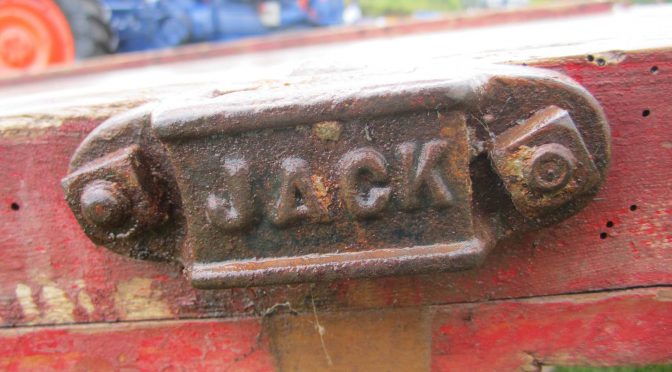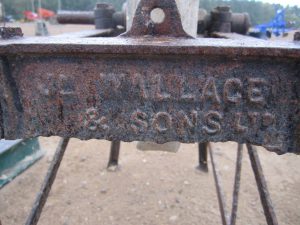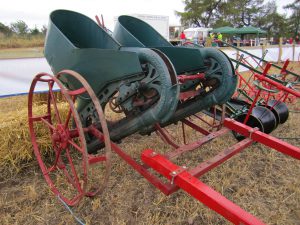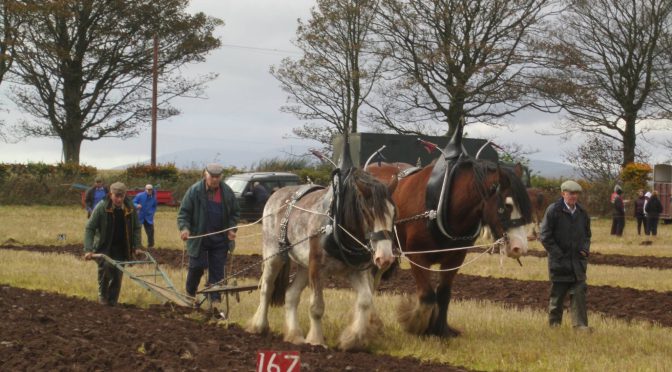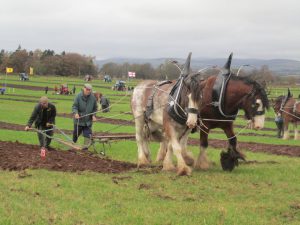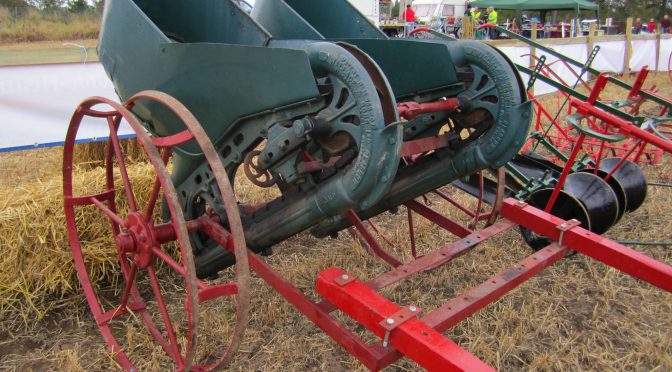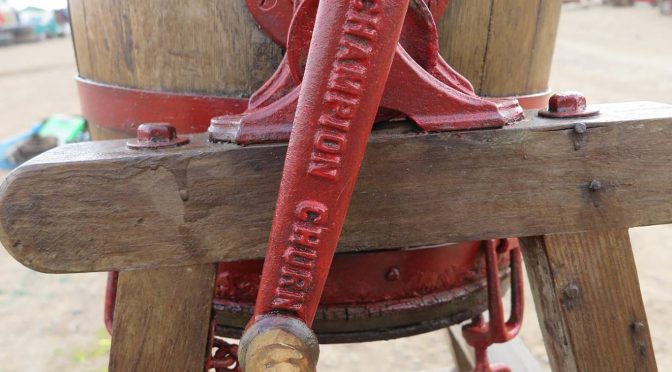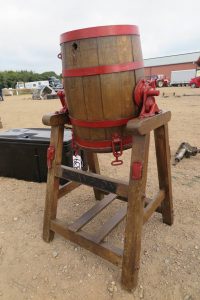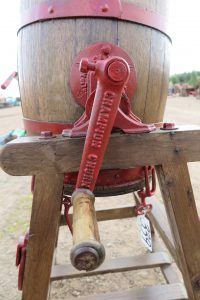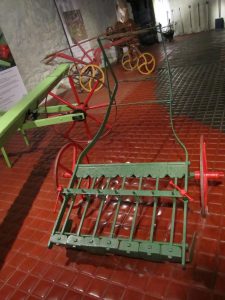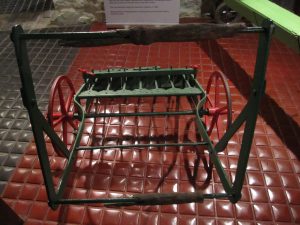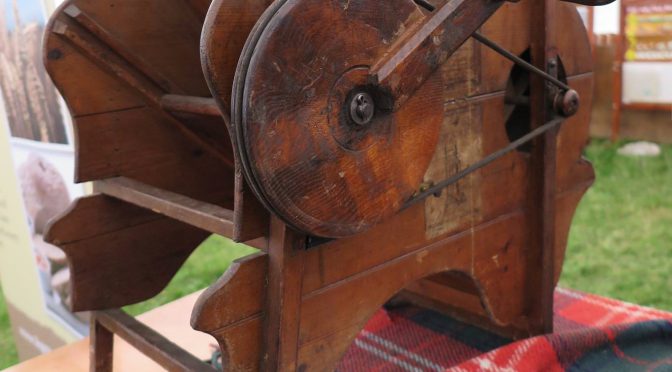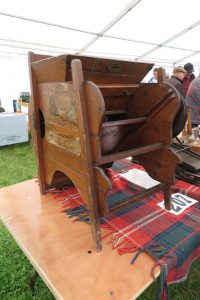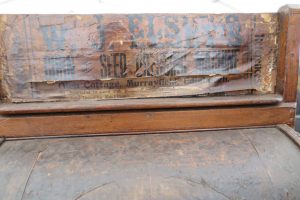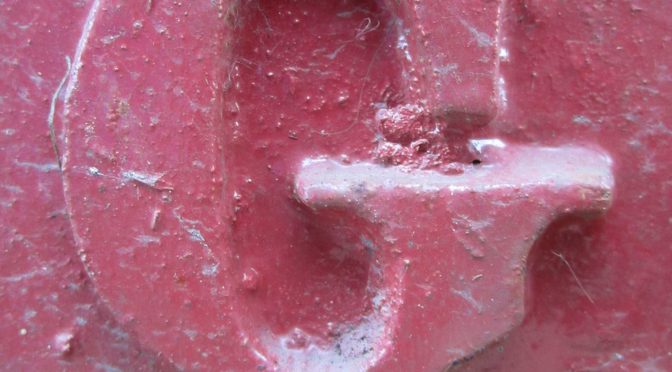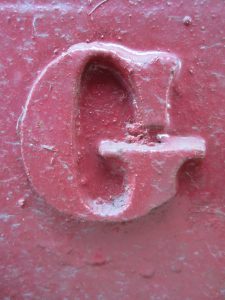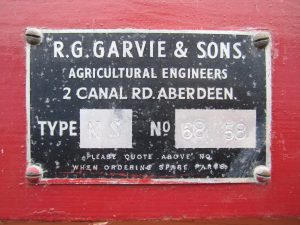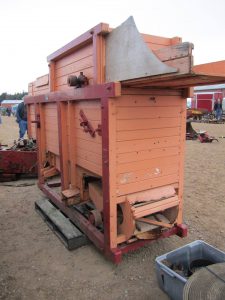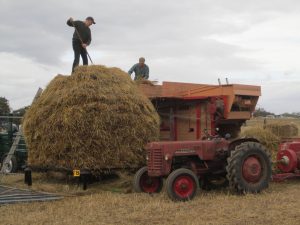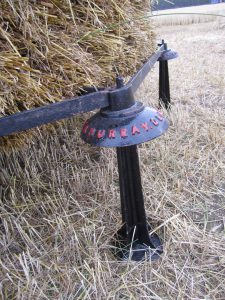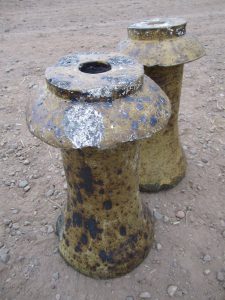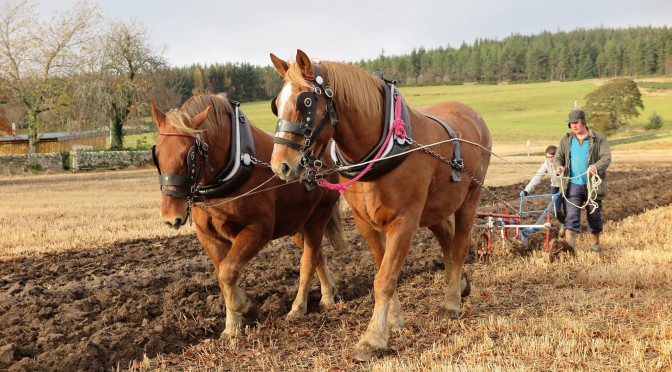Today the Royal Highland Show Show is an important showcase for
new innovations in agricultural machinery. Past shows are important for showing implements and machines that were innovations, novelties, as well as the noted manufactures of their makers. A look at past shows reveals much about what was available to the Scottish farmer and agriculturist.
The Highland Show in 1912 was an important one for the farmers and agriculturists of Fife. It was the first time in the history of the Show, held since 1822 under the auspices of the Highland and Agricultural Society of Scotland, that it was held in Fife, and in the county town. It took place at Kinloss Parks, “just outside the town” between Tuesday and Friday 9-12 July 1912.
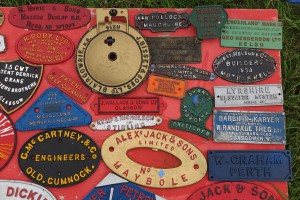 The Scottish agricultural press was excited about the Show: it referred to “the much-talked of Cupar Show”, and noted that it would “be memorable for many things”. They included the weather (always an important aspect of the Highland Show), the impact on the Show by Foot-and-Mouth-Disease which resulted in “depleted pens of cattle and sheep”, and a high attendance on the judging day, the first day of the Show.
The Scottish agricultural press was excited about the Show: it referred to “the much-talked of Cupar Show”, and noted that it would “be memorable for many things”. They included the weather (always an important aspect of the Highland Show), the impact on the Show by Foot-and-Mouth-Disease which resulted in “depleted pens of cattle and sheep”, and a high attendance on the judging day, the first day of the Show.
The Highland Show was a moveable show until 1960, when it moved to its permanent showground at Ingliston, near Edinburgh. In each year from 1827 until 1959 the Show travelled to a new location in Scotland as determined by the Highland and Agricultural Society of Scotland. This system ensured that all the major agricultural districts had access to the Show and allowed as many people as possible to visit it as a national event. It also allowed the Society’s members to know where it was to be located each year, and for arrangements to be put in place for its organisation, including financial assistance for its support.
In this moveable show system, the Highland and Agricultural Society of Scotland divided the country into eight show districts that were each to be visited in a set order. These reflected the main farming areas in Scotland. Fife was located in the Perth Show District. In each of the show districts, the Show was held in the largest settlement: Kelso, Stirling, Inverness, Glasgow, Aberdeen, Edinburgh, Dumfries and Perth. Prior to 1912, the only time that the Show was held in another settlement was in 1890 when it was held in the Dundee. The Cupar Show of 1912 was therefore another departure to the Highland Society’s established model. There was a further departure to it in the following year, 1913, when the Show was held at Paisley, and also in 1914 when it was held at Hawick.
The Show comprised two main sections or departments: (1) livestock and (2) implements and machinery. It is this latter one, the implements and machinery that we will focus on this evening.
The number of implements and machines that were exhibited at the Cupar Show compared favourably with those at the other Highland Shows held between 1900 and 1914. The Cupar Show had 211 exhibitors, and a further eleven offices, largely railway companies and newspapers. It had the fifth largest number of stands during the period, though the Show was much smaller than the one at Edinburgh in 1907, which had 232 stands. On these 211 stands were 1801 exhibits. This was a much smaller number of exhibits that at many of the other shows: the Cupar Show ranked twelfth out of fourteen for the number of exhibits that were exhibited at each Show between 1900 and 1914. That it was a smaller Show is not surprising: before 1900 the Perth Show district ranked the fifth most important (out of eight) for the number of implements and machines exhibited at the Show. Edinburgh always had the largest show, followed those held at Glasgow, Dumfries and Aberdeen; Inverness always had the smallest show.
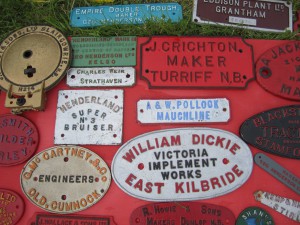 The exhibitors at the Cupar Show, like all the shows in the other show districts, had a distinct geographical distribution. A total of fifteen of the 211 exhibitors were from Fife. A significant number were also from eastern and north-eastern Scotland: nine were from Dundee, thirteen from Aberdeen and Aberdeenshire, and a further nine were from Perthshire. In essence, they were from the Perth Show District in which the county of Fife was located, and the neighbouring show district of Aberdeen.
The exhibitors at the Cupar Show, like all the shows in the other show districts, had a distinct geographical distribution. A total of fifteen of the 211 exhibitors were from Fife. A significant number were also from eastern and north-eastern Scotland: nine were from Dundee, thirteen from Aberdeen and Aberdeenshire, and a further nine were from Perthshire. In essence, they were from the Perth Show District in which the county of Fife was located, and the neighbouring show district of Aberdeen.
Outwith these two show districts, the industrial centres of Edinburgh, Glasgow and Lanarkshire contributed a further 59 exhibitors. England was an important area for exhibitors with twenty from London alone, and a further 58 from the rest of the country. There were, however, few exhibitors from the north of Scotland as well as southern and south-western counties.
This distribution of exhibitors was one that was not peculiar to the Cupar Show, and to the Perth Show District. Rather, it was one that was found for all of the shows in the show districts. The focal point of the Show was always the exhibitors from the Show district where the Show was being held, together with those from the neighbouring Show Districts. A significant number of exhibitors also came from the industrial centres as well as England. The districts in Scotland furthest from the Show and its Show District had few exhibitors from them; sometimes there were none.
The fifteen exhibitors from Fife had a distinct character. Ten of them were from Cupar, the county town; a further two were from Kirkcaldy. The remaining ones were from Pittenweem, Ladybank, and Dunfermline. The implement maker in that last centre, the weighbridge and weighing machine maker, Henry Pooley & Son Limited, was a branch of a larger company from Birmingham with a Scottish works in Glasgow, and a network of Scottish addresses.
The exhibitors from Fife comprised makers and agents of implements and machines. James Low of Knowhead was a maker of ploughs, drill ploughs, harrows and grubbers. William Doig of Cupar, a blacksmith and an implement maker, made a roadscraper, as well as drill ploughs and plough socks. Stephen Bayne, Pitlessie, was a maker of swing ploughs, seed harrows and swingletrees. John Monro, Kirkcaldy, was a maker of tipping carts, hay carts, barrows as well as a potato sorter (“Ness’ Eclipse”). Some of the makers also acted as agents for other makers. They included William Balfour, Ovenstone Works, Pittenweem. In addition to his threshing machines and corn bruisers, he also sold oil engines from Tangyes, Birmingham. Agents included ironmongers which sold a range of implements and machines. For example, Hood & Robertson Ltd sold potato diggers from A. Jack & Sons, as well as oil engines from the International Harvester Co. Ltd.
In addition to these implement and machine makers, the Fife exhibitors also included seed merchants, nurserymen, an agricultural stationer, and a saddler, Alex Honeyman, Cupar.
All of these businesses had a local character. Most were not, either before or after the Show, regular exhibitors to it. Hood & Robertson had been ironmongers since at least 1869, but only exhibited at the Cupar Show in 1912. Stephen Bayne, Pitlessie, and James Low, Cupar, also exhibited only at the Cupar Show. William Balfour, Pittenweem, had been a millwright since at least 1878. He had entered the Highland Society trial of grist mills in 1890 and exhibited at two Highland Shows: those of Dundee in 1890 and Cupar in 1912. His presence at two shows indicated that while he was a local maker, he had a wider customer base than the other Fife exhibitors, across a wider area of eastern Scotland. Another such exhibitor was William Doig of Cupar.
John Monro, Kirkcaldy, was a recently established implement and machine maker, having been in business since at least 1909. By 1920 he had set up the Eclipse Implement Works, which was to become noted for the Eclipse potato sorter, and was to be a regular exhibitor at the Highland Show until 1939. The business continued until at least the late 1950s.
In 1912 none of the exhibitors from Fife that exhibited at the Highland Show at Cupar were major figures in the making of agricultural implements and machines in Scotland. They were essentially small makers with a local customer base in the Perth Show District. So where were the farmers and agriculturists of Fife obtaining their implements and machines from? What was available to them in 1912 at the Highland Show at Cupar?
 The exhibitors at the Cupar Show included some of the most important implement and machine makers and agents in Scotland and England. From Scotland, they included well-established makers that had exhibited at the Show for decades, and already had a national standing and reputation by the end of the nineteenth century: the three makers J. D. Allan & Sons, Murthly, Alexander Shanks & Son, Arbroath, and Thomas Sherriff & Co., West Barns, Dunbar, had been exhibitors at the Show since 1852, and Kemp & Nicholson, Stirling, from 1858. There were others that had started to attend the Show in the 1860s and 1870s. They included John Doe Limited, Errol and Perth, one of the earliest (and also successful) Scottish agricultural implement agents, who started to exhibit in 1869.
The exhibitors at the Cupar Show included some of the most important implement and machine makers and agents in Scotland and England. From Scotland, they included well-established makers that had exhibited at the Show for decades, and already had a national standing and reputation by the end of the nineteenth century: the three makers J. D. Allan & Sons, Murthly, Alexander Shanks & Son, Arbroath, and Thomas Sherriff & Co., West Barns, Dunbar, had been exhibitors at the Show since 1852, and Kemp & Nicholson, Stirling, from 1858. There were others that had started to attend the Show in the 1860s and 1870s. They included John Doe Limited, Errol and Perth, one of the earliest (and also successful) Scottish agricultural implement agents, who started to exhibit in 1869.
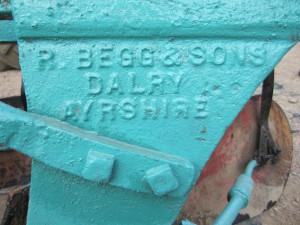 There were also three implement and machine makers that were exhibiting at the show for the first time. They were: Robert Begg & Sons, Dalry, Ayrshire, D. H & F. Reid, Ayr, and David Ritchie, Forfar. Robert Begg, an agricultural implement maker and smith, became a renowned plough maker, and a regular exhibitor to the Highland Show until 1960; he entered a plough in the important exhibition of farm tractors and tractor implements in 1922; he also entered his double furrow self-lift tractor plough as a New Implement to the Highland Show in 1923. D. H. & F. Reid, Ayr, an agricultural engine manufacturer, mechanical engineer and millwright, who started business in the late 1890s and continued until at least 1940, made threshing mills and oil engines, taking over the manufacture of Annan engines in 1912. However, that business only exhibited at a small number of Shows: those of Paisley in 1913, Hawick in 1914 and Edinburgh in 1919. David Ritchie, implement maker, Kincaldrum, Forfar, established in 1870, later became David Ritchie & Sons, Whitehills, Forfar then David Ritchie (Implements) Ltd, Forfar.
There were also three implement and machine makers that were exhibiting at the show for the first time. They were: Robert Begg & Sons, Dalry, Ayrshire, D. H & F. Reid, Ayr, and David Ritchie, Forfar. Robert Begg, an agricultural implement maker and smith, became a renowned plough maker, and a regular exhibitor to the Highland Show until 1960; he entered a plough in the important exhibition of farm tractors and tractor implements in 1922; he also entered his double furrow self-lift tractor plough as a New Implement to the Highland Show in 1923. D. H. & F. Reid, Ayr, an agricultural engine manufacturer, mechanical engineer and millwright, who started business in the late 1890s and continued until at least 1940, made threshing mills and oil engines, taking over the manufacture of Annan engines in 1912. However, that business only exhibited at a small number of Shows: those of Paisley in 1913, Hawick in 1914 and Edinburgh in 1919. David Ritchie, implement maker, Kincaldrum, Forfar, established in 1870, later became David Ritchie & Sons, Whitehills, Forfar then David Ritchie (Implements) Ltd, Forfar.
On display at the Cupar Show was a wide range of manufactures: agricultural implements and machines; dairy implements, stock foods, veterinary medicines, sheep dips, manures, poultry sundries, woolen manufacturers, as well as a range of miscellaneous exhibits for the home, such as washing machines and wringers; a number of agricultural institutions also promoted their work.
The exhibits in the Implement and Machinery Department were arranged into a number of sections: stands in the open air, stands under cover, and the motion yard. The motion-yard was an extensive, and important, section with 53 stands, both open and covered. It included stands occupied by the most important implement makers in Scotland and England. A small number of them, such as Ransomes, Sims & Jefferies Ltd, Ipswich, had stands in both this yard and in other sections of the implement yard. Their stands included all the heavy machines, including traction engines, and forms of power to generate power for Scottish farms and 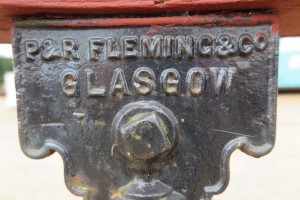
estates, such as oil engines and petrol engines. A number of the exhibits in this yard were “shown in motion”: ie at work. They included “a number of machines” exhibited by P. & R. Fleming, Graham Square, Glasgow, which were “driven by a 6BHP Hornsby engine and a Lister petrol motor”.[1]
The exhibitors exhibited a range of implements and machines that had a number of different characters: ones for which they were renowned for and had a reputation; ones that had improved designs; new implements; and “novelties”. This last one was important in helping to develop innovations and new types of implements and machines for the Scottish agriculturist. There were a number of “novelties” at the Cupar Show. The North British Agriculturist described them as:
“… a new manure distributor by Wallace & Sons of Glasgow; a new separator by the Crown Dairy Co., of Glasgow; a new potato sorter by Messrs Ballach & Sons, Leith; a new digger and also a haulm cutter by the Agricultural Implement Co., Dundee; a new machine by the Dairy Supply Co., Edinburgh; a new molasses mixer by Mr Reader of Winchester; and Grattan’s new dry sprayer, which was awarded the RASE silver medal, is on the stand of Messrs A. & J. Main.”[2]
Ploughs and cultivating machines
There was a strong display of ploughs and cultivating implements at the Cupar Show. These were exhibited by exhibitors from both 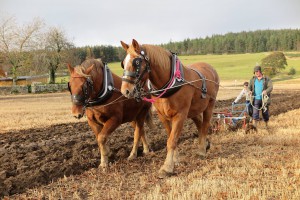 Scotland and England. As may be expected, ploughs were the most frequently exhibited implement among the stands, with a total of 65 of them being exhibited by 14 exhibitors. There were, however, only four exhibitors of corn drills, and only 8 such machines were exhibited. This compared unfavourably with the number of exhibitors of turnip, mangold and carrot sowers, of which there were nine exhibitors that displayed 14 machines.
Scotland and England. As may be expected, ploughs were the most frequently exhibited implement among the stands, with a total of 65 of them being exhibited by 14 exhibitors. There were, however, only four exhibitors of corn drills, and only 8 such machines were exhibited. This compared unfavourably with the number of exhibitors of turnip, mangold and carrot sowers, of which there were nine exhibitors that displayed 14 machines.
 A total of 12 of the 14 exhibitors of ploughs were from Scotland; they also exhibited the majority of the ploughs, some 51 of the 65 on display. They included the major plough makers in Scotland, some of whom had reputations for their manufacture for a number of decades: George Sellar & Son, Huntly, and Alexander Newlands & Son, Linlithgow. Sellar, with their world-renowned ploughs, were reported by the North British Agriculturist to “always make a striking display”. [3]
A total of 12 of the 14 exhibitors of ploughs were from Scotland; they also exhibited the majority of the ploughs, some 51 of the 65 on display. They included the major plough makers in Scotland, some of whom had reputations for their manufacture for a number of decades: George Sellar & Son, Huntly, and Alexander Newlands & Son, Linlithgow. Sellar, with their world-renowned ploughs, were reported by the North British Agriculturist to “always make a striking display”. [3]
Some of the ploughs were also made by small and local plough makers, that were locally important: Stephen Bayne, Pitlessie, Fife, James Law, Knowehead, Fife, Robert Begg & Sons, Dalry, and John Hally, Auchterarder. John Hally was a member of the award-winning Hally family of smiths and farriers of Auchterarder, who had been making ploughs from at least the early 1870s. Hally’s ploughs were “well-known”.[4] Those of Robert Begg & Sons, were “well known over the west of Scotland [and] ha[d] won numerous prizes in Ayrshire, Arran, Islay and elsewhere.”[5] The ploughs were also made by makers that also manufactured a much wider range of implements and machines. They included the three noted firms of Thomas Hunter & Sons, Maybole, Alex Jack & Sons, Maybole, and 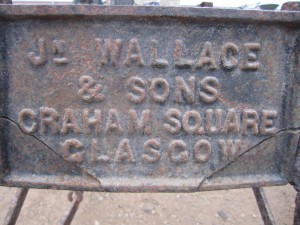 John Wallace & Sons, Glasgow. Alex Jack & Sons was well-known and renowned for its hay-rakes, rick lifters, its range of potato diggers, manure distributors, horse hoes, drill grubbers, carts, and as the sole importer into Scotland of the Canadian Dux Plows. John Wallace & Sons was well-known for its own binders, mowers and reapers, horse-hoes, potato diggers, potato planters, and oil engines, and was an agent for Oliver plows and for other makers such as E. H. Bentall, Heybridge, Malden, Essex.
John Wallace & Sons, Glasgow. Alex Jack & Sons was well-known and renowned for its hay-rakes, rick lifters, its range of potato diggers, manure distributors, horse hoes, drill grubbers, carts, and as the sole importer into Scotland of the Canadian Dux Plows. John Wallace & Sons was well-known for its own binders, mowers and reapers, horse-hoes, potato diggers, potato planters, and oil engines, and was an agent for Oliver plows and for other makers such as E. H. Bentall, Heybridge, Malden, Essex.
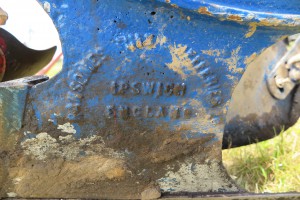 The two English exhibitors of ploughs included the world-renowned ploughmaker Ransomes, Sims & Jefferies Ltd, Ipswich. The other English exhibitor was William Elder & Sons Ltd, Berwick on Tweed. The company was well-known in the Scottish borders, and through its Scottish agents. It also set up a separate, but related company, William Elder & Sons Ltd, in Glasgow at 23 Bellgrove Street, in 1910, which continued in business until late 1916 when it was wound up.[6]
The two English exhibitors of ploughs included the world-renowned ploughmaker Ransomes, Sims & Jefferies Ltd, Ipswich. The other English exhibitor was William Elder & Sons Ltd, Berwick on Tweed. The company was well-known in the Scottish borders, and through its Scottish agents. It also set up a separate, but related company, William Elder & Sons Ltd, in Glasgow at 23 Bellgrove Street, in 1910, which continued in business until late 1916 when it was wound up.[6]
The ploughs included a range of types and models. George Sellar & Son “show[ed] a very large selection of ploughs of all kinds”.[7] R. Begg & Sons had improved chill ploughs with steel bodies and socks, 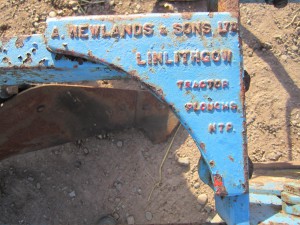 bar point chill ploughs and Alexander Newlands & Sons, had the “chilled steel and drill ploughs, all of the most up-to-date type, with modern attachments and conveniences”.[8] From England, Ransomes, Sims & Jefferies exhibited “a large collection of ploughs”, including their range of Scotch ploughs, steel ploughs, turnwrest plough, potato ploughs, double furrow ploughs. They included their “celebrated” “Newcastle prize ploughs”, described by the North British Agriculturist, as “the most popular general purpose ploughs in the world”.[9]
bar point chill ploughs and Alexander Newlands & Sons, had the “chilled steel and drill ploughs, all of the most up-to-date type, with modern attachments and conveniences”.[8] From England, Ransomes, Sims & Jefferies exhibited “a large collection of ploughs”, including their range of Scotch ploughs, steel ploughs, turnwrest plough, potato ploughs, double furrow ploughs. They included their “celebrated” “Newcastle prize ploughs”, described by the North British Agriculturist, as “the most popular general purpose ploughs in the world”.[9]
Corn drills
There were only four exhibitors of corn drills, and eight such machines, at the Cupar Show. Two of the exhibitors were from Scotland; they displayed four of the drills. But only one of the Scottish exhibitors manufactured the corn drills that they exhibited: Thomas Sherriff & Co., West Barns. Sherriff had been an award-winning maker of corn drills and carrot drills from the 1850s. By the 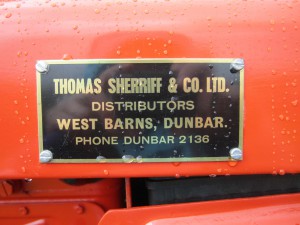 late 1850s the company was one of the most decorated Scottish agricultural implement makers, receiving a clutch of silver medals from the Highland and Agricultural Society of Scotland. In 1912 it exhibited “a number of their lever corn drills for sowing at various widths, all of the most substantial make, on steel frames, and with marking attachments”. It also exhibited “The Small Holdings” seeder, combined drill and broadcast, with five-row adjustable coulters, for all kinds of seeds. This machine was put on the market for the purpose of meeting the demand of the small holder. Turnip, bean, and pea drills, as well as three-row drill manure distributor, besides broad-casters, go to make up the best collection of seed-sowing machines in the yard, a department for which this firm have long enjoyed a high reputation. For strong and lasting build they are unsurpassed.”[10]
late 1850s the company was one of the most decorated Scottish agricultural implement makers, receiving a clutch of silver medals from the Highland and Agricultural Society of Scotland. In 1912 it exhibited “a number of their lever corn drills for sowing at various widths, all of the most substantial make, on steel frames, and with marking attachments”. It also exhibited “The Small Holdings” seeder, combined drill and broadcast, with five-row adjustable coulters, for all kinds of seeds. This machine was put on the market for the purpose of meeting the demand of the small holder. Turnip, bean, and pea drills, as well as three-row drill manure distributor, besides broad-casters, go to make up the best collection of seed-sowing machines in the yard, a department for which this firm have long enjoyed a high reputation. For strong and lasting build they are unsurpassed.”[10]
John Doe Ltd of Errol and Perth exhibited a drill from L. R. Knapp of Thames Valley Iron Works, Clanfield, Oxfordshire, while that company also had its own stand on which were two corn drills, “Monarch” patent corn drills with 12, 13 and 15 rows. John Doe was an important agricultural implement agent, having been in business since at least 1868. The company provided an important focus for the exhibition of implements and machines from major makers including English makers, and for introducing them and their technologies into central Scotland.
Also from England, International Harvester Company of Great Britain Limited, of 80 Finsbury Pavement, London, had two of its own drills, which each had 13 and 14 rows. That company had been exhibiting at the Highland Show since the Dundee Show of 1903; it became a major exhibitor in following decades.
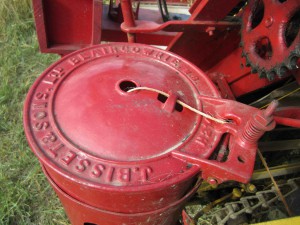 A range of harvesting implements and machines for the hay, grain and potato crops, were exhibited at the Cupar Show. There had been significant changes in the implements and machines used to harvest the grain crop, and especially from the 1870s their technological developments were reflected in the large displays of reaping and mowing machines, and then reaper binders, at the Highland Show. This latter category was the most recent one: the first binders were exhibited at the Show in the late 1880s and the first Scottish made binder was exhibited by J. Bisset & Son Ltd, Blairgowrie in 1893.
A range of harvesting implements and machines for the hay, grain and potato crops, were exhibited at the Cupar Show. There had been significant changes in the implements and machines used to harvest the grain crop, and especially from the 1870s their technological developments were reflected in the large displays of reaping and mowing machines, and then reaper binders, at the Highland Show. This latter category was the most recent one: the first binders were exhibited at the Show in the late 1880s and the first Scottish made binder was exhibited by J. Bisset & Son Ltd, Blairgowrie in 1893.
Reaper-binders
In 1912 there were 17 exhibitors of reaper-binders at the Cupar Show; they exhibited 23 machines. Eleven of the exhibitors were from Scotland, and the remaining six from England. The Scottish exhibitors exhibited 12 of the 23 machines. However, only two of them displayed machines that they had manufactured: J. Bisset & Sons Ltd, Blairgowrie, had three of its steel binders, and John Wallace & Sons, Glasgow, had its Wallace binder with a 5ft cut and cover. In addition, George Sellar & Son, Huntly, also exhibited a Bisset binder.
Most of the Scottish exhibitors of reaper-binders were therefore businesses that were acting as agents for other makers. They included some of the largest and most important implement and machine makers and agents located in the large cities and towns: Barclay, Ross & Tough, Aberdeen, Kemp & Nicholson, Stirling, P. & R. 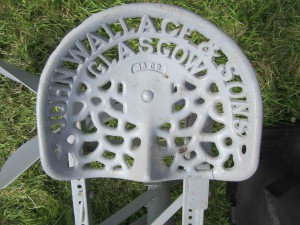 Fleming, Glasgow, and John Wallace & Sons Ltd, Glasgow. Each of them acted as agents for specific makers of reaper-binders and other harvesting machinery; some acted for more than one or a small number of makers. The three exhibitors P. & R. Fleming, Glasgow, H. W. Mathers & Sons, Errol, and George Sellar & Son, Huntly, were all agents for “Albion” reaper binders made by Harrison, McGregor & Co., Albion Iron Works, Leigh, Lancashire, whose manufactures were well-known and widely used throughout Scotland. American and Canadian reapers were also popular with some of the Scottish exhibitors. For example, Hood & Robertson Ltd, Cupar, and Alexander Jack & Sons Ltd, Maybole, were agents for McCormick while Kemp & Nicholson, Stirling, was an agent for Massey Harris Ltd; Charles Weir, Strathaven, was an agent for Walter A. Wood Co., which also had a London address through which British sales were conducted. A. & J. Main & Co., Ltd, Edinburgh, was an agent for Deering. It exhibited Deering’s new “Ideal” binder at the Show. The North British Agriculturist considered that it was an important exhibit. It was:
Fleming, Glasgow, and John Wallace & Sons Ltd, Glasgow. Each of them acted as agents for specific makers of reaper-binders and other harvesting machinery; some acted for more than one or a small number of makers. The three exhibitors P. & R. Fleming, Glasgow, H. W. Mathers & Sons, Errol, and George Sellar & Son, Huntly, were all agents for “Albion” reaper binders made by Harrison, McGregor & Co., Albion Iron Works, Leigh, Lancashire, whose manufactures were well-known and widely used throughout Scotland. American and Canadian reapers were also popular with some of the Scottish exhibitors. For example, Hood & Robertson Ltd, Cupar, and Alexander Jack & Sons Ltd, Maybole, were agents for McCormick while Kemp & Nicholson, Stirling, was an agent for Massey Harris Ltd; Charles Weir, Strathaven, was an agent for Walter A. Wood Co., which also had a London address through which British sales were conducted. A. & J. Main & Co., Ltd, Edinburgh, was an agent for Deering. It exhibited Deering’s new “Ideal” binder at the Show. The North British Agriculturist considered that it was an important exhibit. It was:
“the outcome of experiments conducted for years past through Scotland. The frame of this machine is constructed of high-grade steel, and although light in appearance is still strong beyond any possible requirements The mechanical details have also been simplified, while the capacity has been increased, so that it will harvest effectively the strongest crops, and through the introduction of a new patent adjustable grain deck it will bind crops from one to seven feet in length.”[11]
By comparison to the Scottish exhibitors of reaper-binders, all of the English ones made their own machines. They included two companies based in England that were set up by American and Canadian companies to distribute their manufactures in the British market: International Harvester Co. of Great Britain Ltd, Massey-Harris Ltd, and Walter A. Wood Co. Limited.
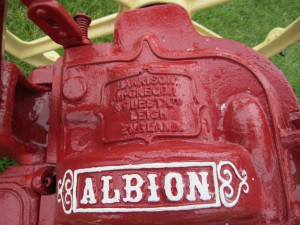 All of the exhibitors with addresses in England were noted reaper and harvesting machine makers with noted reputations, and in some cases world-wide ones. Harrison, McGregor & Co., which had “a very wide collection all over Scotland”, was described by the North British Agriculturist, to be “strong in harvesting machinery of all kinds”.[12] It added that “an imposing array of the Albion binder also attracts much attention. The machines are fitted with roller bearings, canvas stretchers, removable dividers, and improved transport arrangements, and every possible ingenuity has been employed to make them the perfection of a harvesting implement.”[13]
All of the exhibitors with addresses in England were noted reaper and harvesting machine makers with noted reputations, and in some cases world-wide ones. Harrison, McGregor & Co., which had “a very wide collection all over Scotland”, was described by the North British Agriculturist, to be “strong in harvesting machinery of all kinds”.[12] It added that “an imposing array of the Albion binder also attracts much attention. The machines are fitted with roller bearings, canvas stretchers, removable dividers, and improved transport arrangements, and every possible ingenuity has been employed to make them the perfection of a harvesting implement.”[13]
Potato diggers and raisers
 Potato diggers and raisers formed a large class of implements and machines at the Cupar Show. Mechanical potato lifters had been exhibited at the Highland Show since 1856, when Robert Law of Shettleston, exhibited Hanson’s patent potato digger; in essence, it was the first spinner digger.
Potato diggers and raisers formed a large class of implements and machines at the Cupar Show. Mechanical potato lifters had been exhibited at the Highland Show since 1856, when Robert Law of Shettleston, exhibited Hanson’s patent potato digger; in essence, it was the first spinner digger.
In 1912 there were 18 exhibitors of potato diggers and raisers at the Show. They displayed 31 exhibits. Fifteen of the exhibitors were from Scotland, while three were from England. The Scottish 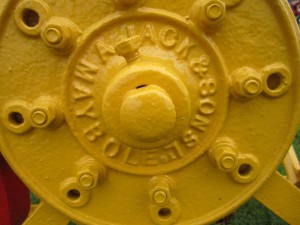 exhibitors displayed 26 of the 31 machines. They included the most important makers of potato diggers and raisers in Scotland, which also exhibited their own machines: J. D. Allan & Sons, J. Bisset & Sons Ltd, Alex Jack & Sons Ltd, and John Wallace & Sons Ltd. Not only were these makers well-known in Scotland, as also throughout England, but over a much wider area. For example, in 1912 Alexander Jack & Sons Ltd had a “world-wide fame” for its potato diggers.[14]
exhibitors displayed 26 of the 31 machines. They included the most important makers of potato diggers and raisers in Scotland, which also exhibited their own machines: J. D. Allan & Sons, J. Bisset & Sons Ltd, Alex Jack & Sons Ltd, and John Wallace & Sons Ltd. Not only were these makers well-known in Scotland, as also throughout England, but over a much wider area. For example, in 1912 Alexander Jack & Sons Ltd had a “world-wide fame” for its potato diggers.[14]
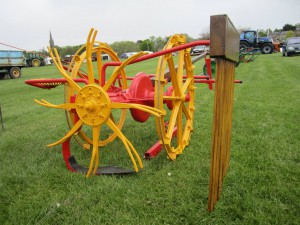 By 1912, a number of these Scottish exhibitors had been manufacturing potato diggers and raisers for a number of decades; they had also won important competitions and trials. Jack of Maybole’s “Caledonian” potato digger won the 1896 competition of potato raisers under the auspices of the Royal Agricultural Society of England. In the 1911 Highland and Agricultural Society of
By 1912, a number of these Scottish exhibitors had been manufacturing potato diggers and raisers for a number of decades; they had also won important competitions and trials. Jack of Maybole’s “Caledonian” potato digger won the 1896 competition of potato raisers under the auspices of the Royal Agricultural Society of England. In the 1911 Highland and Agricultural Society of
Scotland trials at Turnhouse, Midlothian, equal premiums were awarded to J. D. Allan & Sons, Andrew Pollock, Mauchline, John Wallace & Sons, Glasgow, and David Wilson, East Linton, though no overall award was made.[15] That trial was an important one, to encourage the development of harvesters “on entirely new principles, or possess radical improvements on machines in use.” Some of the machines that had been at the trial at Turnhouse in 1911 were at the Cupar Show. J. D. Allan & Sons brought their potato digger that they had entered and which “did such good work. Jack of Maybole brought its “Empire” potato digger with new graip action, digging forks and seats. As the North British Agriculturist  noted, it was “a digger on the Harder principle, with a patented improvement for adjusting the angle of inclination of the digging forks, as found necessary in different conditions of soil.”[16] David Wilson, East Linton, exhibited his “Excelsior” potato digger “which has been improved since its appearance at the Royal trials last season by the introduction of revolving cutters at each side of the drill, to overcome the difficulty of choking which befell it at the English trials last September.”[17] It had, nevertheless, produced “excellent work”.[18]
noted, it was “a digger on the Harder principle, with a patented improvement for adjusting the angle of inclination of the digging forks, as found necessary in different conditions of soil.”[16] David Wilson, East Linton, exhibited his “Excelsior” potato digger “which has been improved since its appearance at the Royal trials last season by the introduction of revolving cutters at each side of the drill, to overcome the difficulty of choking which befell it at the English trials last September.”[17] It had, nevertheless, produced “excellent work”.[18]
Nine of the Scottish exhibitors of potato diggers and raisers exhibited machines from other makers, with those of Jack of Maybole and Ransomes, Sims & Jefferies, Ipswich, being the most popular. Ransomes also exhibited its own potato diggers: it had three entries in the Show Catalogue which included six machines: three potato diggers with fixed tine and guard; a potato digger with hanging forks, fitted with front wheel and seat, or pole and whipps, and two potato diggers, with hanging forks and pole. Each of the three English exhibitors of potato diggers and machines exhibited machines that had been made by them.
Power for the farm
Another group of machines included oil engines, motor engines, traction and locomotive engines, steam engines and road rollers. Apart from horses, each of these forms of power played an important role in providing power on the farm and estate and for a wide range of activities, especially for barn work and work in the dairy.
Traction and steam engines
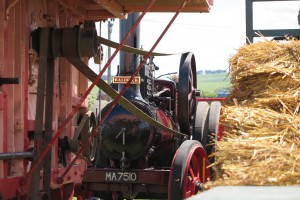 Of these classes, the traction and steam engines formed a significant size of exhibit. Traction and steam engines were first exhibited at the Highland Show at Glasgow in 1850 when Clayton, Shuttleworth & Co., Lincoln, displayed a 7hp portable steam engine. However, it was not until 1857 that there were a number of exhibitors of them at a Show, when there were ten at the Glasgow Show of that year. The second half of the 1870s saw the largest displays of steam engines. They included portable engines, agricultural traction engines, as well as steam ploughing engines, such as those manufactured by John Fowler & Co., Leeds, the largest manufacturer in Britain, and with a world-wide reputation for them.
Of these classes, the traction and steam engines formed a significant size of exhibit. Traction and steam engines were first exhibited at the Highland Show at Glasgow in 1850 when Clayton, Shuttleworth & Co., Lincoln, displayed a 7hp portable steam engine. However, it was not until 1857 that there were a number of exhibitors of them at a Show, when there were ten at the Glasgow Show of that year. The second half of the 1870s saw the largest displays of steam engines. They included portable engines, agricultural traction engines, as well as steam ploughing engines, such as those manufactured by John Fowler & Co., Leeds, the largest manufacturer in Britain, and with a world-wide reputation for them.
By 1912 traction engines were exhibited at the Show in much smaller numbers, though, as noted, they formed the largest class of motive power. All the major makers were in attendance. Each of the 11 traction engine makers at the Show were from England. Each of them exhibited their own engines, though usually only one or two in number. John Fowler & Co., Ltd, Leeds, exhibited its 7hp single cylinder general purpose traction engine, with winding forward drum and rope, water lifter &c (£488) and a compound spring mounted road tractor (£500). Charles Burrell & Sons Limited, Thetford, exhibited three engines: a 6hp traction engine, fitted with single crank compound cylinders, winding drum and wire lifter and hose, and outfit (£520); a tractor (£500), and a steam wagon (£550). Clayton & Shuttleworth exhibited “their newly designed steam motor tractor, suitable for light haulage.” It had “a number of important improvements … which make it most efficient and reliable.”[19]
Motor tractors
Motor tractors formed a small display at the Show. They were also a relatively new feature. They were smaller and lighter traction engines, that were designed “to come within the Motor Car Act”. They were exhibited by three exhibitors, who displayed a total of five exhibits. All of them were from England and were associated with the manufacture of traction and locomotive engines: Aveling & Porter Ltd, Rochester, Clayton & Shuttleworth Ltd, Lincoln, and Richard Garrett & Sons Ltd, Leiston.
Garret was the largest exhibitor, with three entries: a 4 hp compound steam motor tractor; a 5 ton steam motor wagon; and a 6 horse power superheated steam traction engine. Clayton & Shuttleworth Limited, had on entry, a compound motor tractor, “suitable for light haulage”.
Engines for power
There were other types of engines at the Cupar Show that produced power for the Scottish farms and estates. Gas engines had been first exhibited at the Highland Show at Glasgow in 1882. In that year Crossley Brothers Limited, Glasgow, Manchester and London, displayed a small collection. The first petrol engine was exhibited at the Glasgow Show of 1888 by Priestman Brothers, Holderness, Foundry, Hull. The first oil gas engine was exhibited at the Stirling Show of 1891 by Crossley Brothers Limited, Manchester. The first oil engine was also exhibited at the Stirling Show of 1891. This was by Priestman Brothers Limited, Holderness Foundry, Hull.
Oil engines
By 1912, a number of exhibitors were displaying a range of different engines. Of them, oil engines formed a significant display. They were exhibited by 24 exhibitors. They exhibited 44 engines. The large size of this display is not surprising. According to the oil engine maker, Eric Nicholson Ltd, Annan, in 1909:
“it is well known that oil engines are popular, and in constant demand everywhere-a demand which is becoming greater as the benefits derived from their use are becoming known to the public-and the uses which they are put to being added from time to time.”
He also noted that:
“oil engines, have, in many instances, replaced steam engines, and possess many features, such as efficiency, economy, simplicity, portability, and cleanliness, which render them of great value, particularly to farmers; and there is every reason to believe that they will, in the future, be used much more extensively on the land.”
However, by comparison to other makers, there were a “limited number of makers of oil engines, compared with the number of manufacturers of other classes of machinery.”[20]
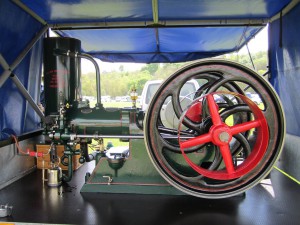 A total of 17 of the 24 exhibitors of oil engines were from Scotland; the remaining seven were from England. The Scottish exhibitors included some of the most important makers. They included Allan Brothers, Ashgrove Engineering Works, Aberdeen, W. & S. Pollock & Co., Glasgow, and Alex Shanks & Son Ltd, Arbroath. Allan Brothers exhibited five engines that ranged from a 9bhp one to a 23bhp one of the “latest improved type, specially designed for agricultural purposes and to work with any brand of oil”.[21] Shanks had three engines, from a 5bhp oil engine, stationary type, with all accessories, to a 14bhp, also of stationary type. D. H. & F. Reid exhibited “Annan” oil engines. These included an “11 brake horse power, Annan oil engine, suitable for driving 36in threshing machine”. Another exhibitor of the “Annan” oil engine, an 11BHP one, was Robert G. Garvie, Aberdeen, well-known for their threshing mills. The Annan engines had been made by Eric Nicholson & Co. Ltd, The Standard Works, Port Street, Annan. The company was established by Eric Nicholson, a mechanical engineer and millwright, in 1901 or 1902. So that he could develop and expand his business, and especially the manufacture of oil engines, Eric Nicholson incorporated his business on 31 May 1909. It was to undertake ‘the business of manufacturers, factors, merchants, hirers, repairers, and dealers of oil, petrol, steam and gas engines and of such machinery as may be utilized by agriculturists and others.[22] However, the company resolved to wind up on 2 May 1911. By the time of the 1912 Cupar Show D. H. & F. Reid had “recently acquired the goodwill of the Annan Oil Engine, and are now manufacturing this in all sizes”.[23]
A total of 17 of the 24 exhibitors of oil engines were from Scotland; the remaining seven were from England. The Scottish exhibitors included some of the most important makers. They included Allan Brothers, Ashgrove Engineering Works, Aberdeen, W. & S. Pollock & Co., Glasgow, and Alex Shanks & Son Ltd, Arbroath. Allan Brothers exhibited five engines that ranged from a 9bhp one to a 23bhp one of the “latest improved type, specially designed for agricultural purposes and to work with any brand of oil”.[21] Shanks had three engines, from a 5bhp oil engine, stationary type, with all accessories, to a 14bhp, also of stationary type. D. H. & F. Reid exhibited “Annan” oil engines. These included an “11 brake horse power, Annan oil engine, suitable for driving 36in threshing machine”. Another exhibitor of the “Annan” oil engine, an 11BHP one, was Robert G. Garvie, Aberdeen, well-known for their threshing mills. The Annan engines had been made by Eric Nicholson & Co. Ltd, The Standard Works, Port Street, Annan. The company was established by Eric Nicholson, a mechanical engineer and millwright, in 1901 or 1902. So that he could develop and expand his business, and especially the manufacture of oil engines, Eric Nicholson incorporated his business on 31 May 1909. It was to undertake ‘the business of manufacturers, factors, merchants, hirers, repairers, and dealers of oil, petrol, steam and gas engines and of such machinery as may be utilized by agriculturists and others.[22] However, the company resolved to wind up on 2 May 1911. By the time of the 1912 Cupar Show D. H. & F. Reid had “recently acquired the goodwill of the Annan Oil Engine, and are now manufacturing this in all sizes”.[23]
Some six of the Scottish exhibitors exhibited oil engines from other makers. This included engines made by manufacturers in both Scotland and England, of which the latter were the most popular. Especially prevalent were those by Blackstone & Co., Stamford, and Richard Hornsby & Sons Ltd, the latter of which also had its own stand at the Show. Scottish exhibitors also exhibited engines from Campbell Gas Engine Co. Ltd, Halifax and Tangyes Ltd, Birmingham and Glasgow. These engine makers also had their own stands at the Cupar Show.
The English exhibitors included all of the major makers of oil engines used for agricultural use. They were also well-known throughout Scotland in 1912: Campbell Gas Engine Co. Ltd, Halifax, Richard Hornsby & Sons Ltd, Grantham, National Gas Engine Co. Ltd, Ashton under Lyne, Ruston, Proctor & Co., Lincoln, and Tangyes Ltd, Birmingham and Glasgow. Each of them exhibited a small number of their own engines, all of their own make.
Barn machinery
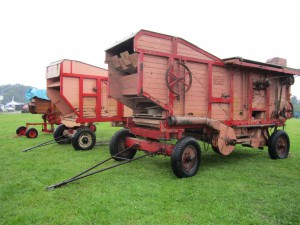 Another significant department at the Show was barn machinery. This included threshing machines and mills, fanners, winnowing and dressing machines, root pulpers, slicers and cutters, oat, bean bruisers and crushers and chaff cutters.
Another significant department at the Show was barn machinery. This included threshing machines and mills, fanners, winnowing and dressing machines, root pulpers, slicers and cutters, oat, bean bruisers and crushers and chaff cutters.
Threshing machines and mills
Of these machines, the largest exhibit in the barn machinery department was the threshing machines and mills, of which 14 exhibitors displayed 29 exhibits. A total of 8 of the 14 exhibitors were from Scotland; they exhibited 21 of the 29 threshing machines and mills. They included the leading threshing mill makers in 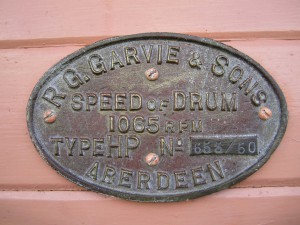 Scotland: Allan Brothers, Aberdeen, Barclay, Ross & Tough, Aberdeen, Bon Accord Engineering Co. Ltd, Aberdeen, and Robert G. Garvie, Aberdeen. The large presence of makers from Aberdeen reflected the eminence of the thrashing machine makers in that area, and the important mill-making trade there. Also present was Wm Dickie & Sons, East Kilbride, an implement and machine maker that was perhaps better known for its windmills, dairy goods and hay turners.
Scotland: Allan Brothers, Aberdeen, Barclay, Ross & Tough, Aberdeen, Bon Accord Engineering Co. Ltd, Aberdeen, and Robert G. Garvie, Aberdeen. The large presence of makers from Aberdeen reflected the eminence of the thrashing machine makers in that area, and the important mill-making trade there. Also present was Wm Dickie & Sons, East Kilbride, an implement and machine maker that was perhaps better known for its windmills, dairy goods and hay turners.
Though most of these makers were well-renowned, they were still relatively young: Robert G. Garvie, who had been with Ben. Reid & Co., started his own business in 1894, Allan Brothers, started business around 1898, Bon Accord Engineering Co., started in 1907.
These Scottish exhibitors exhibited a wide range of threshing machines. The largest machine was from Allan Brothers, which exhibited a 4ft 6 in finishing thrashing machine, with 24 in drum, double crank shakers, corn-screens and improved easily accessible adjustable awner. The Bon Accord Engineering Co. Ltd, had a “21 in wide single dressing thrasher”, “a size very largely used on smaller-sized farms, and is a fitting example of how first-class thrashing can be done by means of a narrower machine.”[24] Robert G. Garvie exhibited four machines which extended from a 3ft 6 in wide, high speed one, to a 1ft 9 in wide medium speed one, to a hand and foot threshing machine. Garvie had been selling its own hand and foot threshers in their thousands since 1872 when they were first exhibited at the Highland Show, as a “new invention”. They came in a number of models such as the “Tiny” and later the “Crown”.
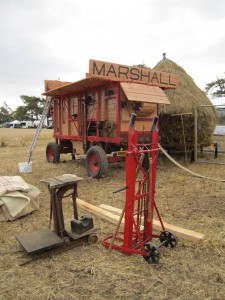 The six English makers were also all leading threshing machine makers. Each of them exhibited their own machines. Each of them were also traction engine makers. Indeed, each of them also exhibited traction engines at the Show. They generally had large machines: the three exhibitors Ransomes, Sims & Jefferies Ltd, Richard Garrett & & Sons Ltd, Clayton & Shuttleworth Limited, each had exhibited 54 inch finishing thrashing machines. The three makers Wm Foster & Co. Limited, Ruston, Proctor & Co Ltd, Lincoln, and Marshall, Sons & Co Ltd, Gainsborough, also had 4ft 6 in by 22 inch thrashing machines.
The six English makers were also all leading threshing machine makers. Each of them exhibited their own machines. Each of them were also traction engine makers. Indeed, each of them also exhibited traction engines at the Show. They generally had large machines: the three exhibitors Ransomes, Sims & Jefferies Ltd, Richard Garrett & & Sons Ltd, Clayton & Shuttleworth Limited, each had exhibited 54 inch finishing thrashing machines. The three makers Wm Foster & Co. Limited, Ruston, Proctor & Co Ltd, Lincoln, and Marshall, Sons & Co Ltd, Gainsborough, also had 4ft 6 in by 22 inch thrashing machines.
Chaff cutters
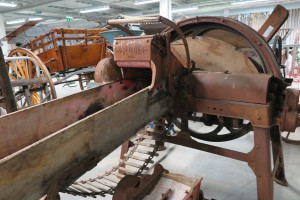 Chaff cutters were exhibited by seven exhibitors. They exhibited 22 machines. Three of the seven exhibitors were from Scotland; each of them exhibited one machine. Barclay, Ross & Tough, Aberdeen, exhibited its CD4 chaff cutter while the other two Scottish exhibitors exhibited machines from English makers: P. & R. Fleming & Co., Glasgow, was agent for Richmond & Chandler Ltd, Manchester, which also had its own stand, exhibiting seven of its own chaff cutters. Charles Weir, Strathaven, was an agent for Harrison, McGregor & Co., which also had its own stand with two of its own chaff cutters.
Chaff cutters were exhibited by seven exhibitors. They exhibited 22 machines. Three of the seven exhibitors were from Scotland; each of them exhibited one machine. Barclay, Ross & Tough, Aberdeen, exhibited its CD4 chaff cutter while the other two Scottish exhibitors exhibited machines from English makers: P. & R. Fleming & Co., Glasgow, was agent for Richmond & Chandler Ltd, Manchester, which also had its own stand, exhibiting seven of its own chaff cutters. Charles Weir, Strathaven, was an agent for Harrison, McGregor & Co., which also had its own stand with two of its own chaff cutters.
The four English exhibitors of chaff cutters were all major makers of them, and each of them exhibited their own machines: E. H. Bentall & Co., Clayton & Shuttleworth Ltd, Harrison, McGregor & Co. Ltd, and Richmond & Chandler Ltd, Manchester.
Root pulpers, slicers and cutters
Another group of implements at the Cupar Show was root pulpers, slicers and cutters. These were exhibited by nine exhibitors who exhibited 15 machines. Some five of the exhibitors were from Scotland, and they exhibited eight of the machines. Most of them exhibited machines from other makers. Especially important were the turnip cutters from Gardner: “Gardner’s turnip cutter”. These had been long in use, since at least the 1840s. Writing in 1843, James Allen Ransome, noted “readers will not fail to recognize … Gardner’s Patent Turnip Cutter”.[25] Three of the exhibitors in England also made their own turnip cutters. They were makes that were also noted makers of food processing machines: E. H. Bentall & Co. Ltd, Essex, and Richmond & Chandler Ltd, Manchester.
The range of machinery
There was therefore a wide range of implements and machines available to the farmer and agriculturist at the Highland Show at Cupar in 1912. All the leading Scottish and English makers were in attendance at the show, as well as some of the local makers from Fife itself. They exhibited their established as well as their new implements and machines as well as “novelties”, and some also acted as agents for other makers so that they could extend their range to their customer. Some of the large companies in the large cities and towns such as P. & R. Fleming & Co., John Wallace & Sons Ltd, were clearing houses, supplying a wide range of manufactures for farmers as well as those from other noted makers for which they acted as agents.
Their exhibits also revealed the making of agricultural implements and machines along national as well as geographical lines. There were large displays of ploughs, potato diggers and raisers and threshing machines by Scottish makers. There were large displays of reaper binders by English companies, as well as those with addresses in England. There were also large displays of oil engines, petrol engines, motor tractors, traction and locomotive engines, chaff cutters and root pulpers, slicers and cutters, by makers in England, with some of these types only being made by makers in England.
The making of agricultural implements and machines which had been undertaken largely on local lines in the mid 1850s had become a highly industrialized industry, with large companies with international markets, down to small makers with local ones. The making of particular implements had become specialized and confined to particular makers in specific geographical areas of Britain. What the Fife farmer had available to him at the Cupar Show of 1912 was a remarkable collection of implements and machines that allowed him to practice modern farming methods. It was a selection that had it been shown to farmers fifty years earlier it would have looked unrecognizable to the farmers and agriculturists of the day. But it was also one that would look in many ways unrecognizable to farmers some fifty years later.
Source: North British Agriculturist, 22 July 1912, Highland and Agricultural Society of Scotland, Highland Show, Implement and Machinery Department, Cupar, 9-12 July 1912, Edinburgh, 1912.
© Heather Holmes 2015 (text and photographs)
[1] North British Agriculturist, 22 July 1912.
[2] North British Agriculturist, 22 July 1912.
[3] North British Agriculturist, 22 July 1912.
[4] North British Agriculturist, 22 July 1912.
[5] North British Agriculturist, 22 July 1912.
[6] National Records of Scotland, BT2/7478, Wm Elder & Sons (Glasgow) Ltd.
[7] North British Agriculturist, 22 July 1912.
[8] North British Agriculturist, 22 July 1912.
[9] North British Agriculturist, 22 July 1912.
[10] North British Agriculturist, 22 July 1912.
[11] North British Agriculturist, 22 July 1912.
[12] North British Agriculturist, 22 July 1912.
[13] North British Agriculturist, 22 July 1912.
[14] North British Agriculturist, 22 July 1912.
[15] “Trial of potato diggers or lifters”, Transactions of the Highland and Agricultural Society of Scotland, 1911, pp. 383-398.
[16] North British Agriculturist, 22 July 1912.
[17] North British Agriculturist, 22 July 1912.
[18] North British Agriculturist, 22 July 1912.
[19] North British Agriculturist, 22 July 1912.
[20] National Records of Scotland, BT2/7145, Eric Nicholson & Company Limited.
[21] North British Agriculturist, 22 July 1912.
[22] NRS, BT22/7145, Eric Nicholson & Company Limited.
[23] North British Agriculturist, 22 July 1912.
[24] North British Agriculturist, 22 July 1912.
[25] James Allen Ransome, The Implements of Agriculture, London, 1893, p. 194.
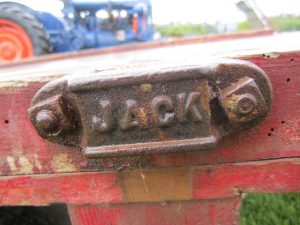 The company was highly renowned, even from its early days. Its founder, Alexander Jack, died in June 1877. The North British Agriculturist carried an obituary in its columns of 13 June 1877:
The company was highly renowned, even from its early days. Its founder, Alexander Jack, died in June 1877. The North British Agriculturist carried an obituary in its columns of 13 June 1877: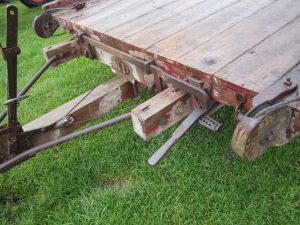 partner of the well-known firm of Alexander Jack & Sons, agricultural implement makers, maypole. At the outset of his career, Mr Jack was apprenticed as a joiner, and afterwards carried on successfully the business of a wood-merchant at Auchendrane, a few miles out of Maybole. About thirty years ago, he removed to Maybole, to meet the requirements of his yearly increasing trade. He subsequently applied himself to the manufacture of agricultural implements with such a large measure
partner of the well-known firm of Alexander Jack & Sons, agricultural implement makers, maypole. At the outset of his career, Mr Jack was apprenticed as a joiner, and afterwards carried on successfully the business of a wood-merchant at Auchendrane, a few miles out of Maybole. About thirty years ago, he removed to Maybole, to meet the requirements of his yearly increasing trade. He subsequently applied himself to the manufacture of agricultural implements with such a large measure 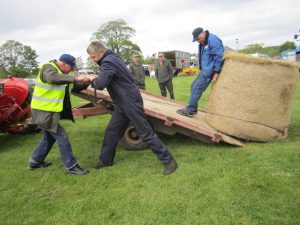 of success that his fame soon spread, and since then the firm of which he was the distinguished head have been among the foremost prize-winners wherever their implements have been exhibited. Mr Jack, like most men who have won their way to enviable distinction, took an intelligent and lively interest in all the affairs of his farm. Last year, in the course of an American tour, he visited the works of several of the leading implement makers in the United States. His loss is lamented by a wide circle of friends, particularly in the neighbourhood of Maybole, which has largely profited by the local industry of which he was the founder.”
of success that his fame soon spread, and since then the firm of which he was the distinguished head have been among the foremost prize-winners wherever their implements have been exhibited. Mr Jack, like most men who have won their way to enviable distinction, took an intelligent and lively interest in all the affairs of his farm. Last year, in the course of an American tour, he visited the works of several of the leading implement makers in the United States. His loss is lamented by a wide circle of friends, particularly in the neighbourhood of Maybole, which has largely profited by the local industry of which he was the founder.”